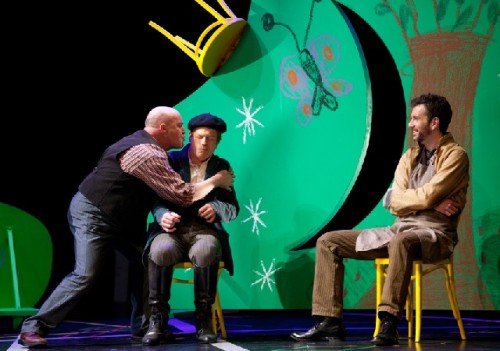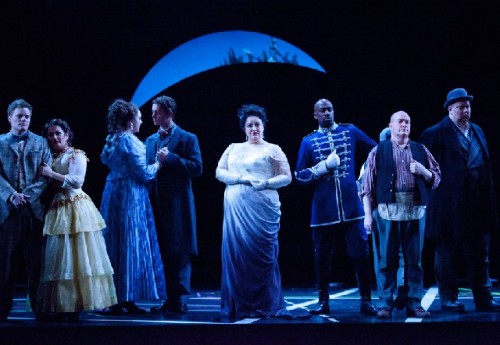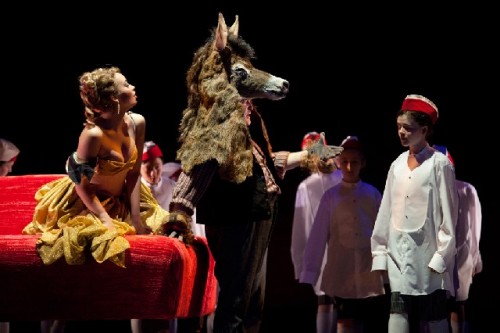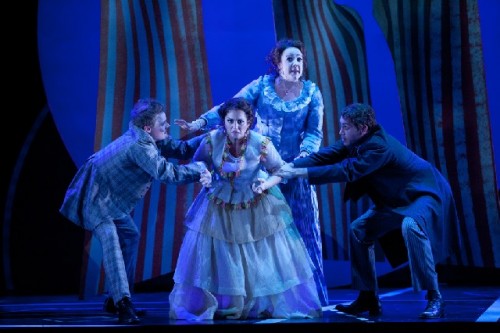Boston Lyric Opera's A Midsummer Night's Dream
Magic Lost in Misconceived Production
By: David Bonetti - May 02, 2011
A Midsummer Night’s Dream
By Benjamin Britten
Boston Lyric Opera
Additional performances May 4, 6, 8 and 10 at the Shubert Theatre
More info: www.blo.org or 617-542-6772
Benjamin Britten’s A Midsummer Night’s Dream can be one of the most charming works in the opera repertory. A close adaptation of Shakespeare’s play by Britten and his partner, the tenor Peter Pears, it features a children’s fairy chorus, a crew of charmingly crude rustics, one of whom is transformed – “translated” in Shakespeare’s word - into a donkey, a mischievous sprite, two pairs of crossed lovers and a fairy king and queen who set the play in action by their competition to possess an Indian boy. As a magical comedy it can compare with “Falstaff,” Verdi’s Shakespearean adaptation, and that’s very high praise indeed.
So what went wrong at the Shubert Theatre Friday night? In the production designed by the usually estimable John Conklin there was little charm and less magic. In apparent search of deeper meaning, Conklin, enabled by stage director Tazewell Thompson, seems to have lost the work’s surface pleasures. (Costume designer Kaye Yoyce is largely exempt from criticism.) If Britten had wanted to explore Freudian ideas in his opera, which premiered in 1960, he would have but he didn’t. He was content with the world of dreams Shakespeare created. In Conklin’s interpretation of this dream world that takes place deep in the forest, not only is there no forest, there are no trees. Oh, there is a scene that is too clever for its own good in which flats labeled “tree,” “leaf” and “moon” descend from above to set the scene. Confusing old-time fairy tales with surrealism, Conklin evokes Magritte – in a scene filled with floating yellow bentwood chair – and Man Ray in which his famous image of a woman crying a crystal tear serves as a moon.
Britten sets the scene in fairyland from his very first notes – unnerving glissandi from the orchestra that return on a regular basis to remind us that we are not in a normal world that functions according to the laws of physics or of time. But the production resists the musical cues and takes forever to get going. The first hour of the three-hour work is tedious. It’s not until the end of the first act – there are three but it is done by the Lyric in two parts, so the first act does not end at the first intermission – that there is any charm. Tytania, the fairy queen, sings some lovely faux-coloratura passages before she bids her fairy retinue to sing her to sleep. A large red chaise is her bed of choice and a photo session is set up to capture her and her fairy cohort before they give way to slumber. But it took so long to get there that the charm was too little and too late.
The fairies create another rare moment of magic at the end of Act II. Puck, the sprite, has sprinkled magic potion on the eyes of the lovers who have been mismatched by the same fairy dust he dispensed earlier, so that when they wake they will recognize their proper mate. While the lovers sleep, the fairies, dressed cutely in little good-humor style caps and long white smocks, come in the darkling space carrying metal rods with twisted ends singing a lovely chorus, “Jack shall have his Jill/Naught shall go ill.”
And of course whenever the rustics appear there is delight to spare. We all love low humor, don’t we? (Shakespeare did and so did Britten.) The play they put on for the wedding of King Theseus and Hippolyta – by the way, this all takes place in or around a fantastical Athens – is as one of the on-stage audience notes, “The silliest thing I’ve ever seen.” And that’s as it should be.
The production’s misconceptions were all the more a shame because musically the evening was one of great satisfaction. The orchestra, richly colored by woodwinds, horns and percussion, played brilliantly under conductor David Angus, leading the orchestra in his first outing as the company’s new music director. We can hope for great things in the future.
The large cast was uniformly excellent. The rustics were not only charming but vocally strong. Baritone Andrew Shore as Bottom, the nervously aggressive weaver who is turned into an ass and briefly, in donkey drag, into fairy queen Tytania’s lover, was outstanding. The fairies, treble and soprano youths from Boston’s PALS Children’s Chorus, nearly stole the evening – as children’s choruses often do. The two pairs of Athenian lovers who undergo such ordeals for fairy king Oberon’s pleasure – tenor Chad A. Johnson as Lysander, mezzo Heather Johnson as Hermia, baritone Matthew Worth as Demetrius and soprano Susanna Phillips as Helena - were a pleasure for the audience as well. A special shout out to Phillips, who usually sings leads in major houses – I heard her as the Countess in “Le Nozze di Figaro” in Santa Fe. Her small role here counts as luxury casting. And Darren K. Stokes as Theseus and Ann McMahon Quinteror as Hippolyta were as formal as royals in such operas should be.
Special praise goes to the opera’s two principals - the fairy king and queen. As Oberon countertenor John Gaston was a vocal delight. A hunky and virile countertenor with a shaved head, he was the man in control of the evening’s proceedings. Rarely have we seen such a butch fairy. (If only he had been given power over the production!) His voice never sounded unnatural – an achievement for a countertenor. He was given a wide range of music to sing and was at his best in the madrigal “I know a bank where the wild thyme blows,” in which Britten shows his own debt to British forebears like Henry Purcell. But he was also beguiling in the aria “Now until the break of day” that slows the action down and heralds the end of the opera. Nadine Sierra, a regular with the San Francisco Opera, was a gorgeous Tytania. Her lovely lyric soprano played knowingly with bel canto coloratura as Britten intended.
The only disappointment among the performers was Karim Salayman as Puck, and that was a fault more of the production concept than of his own talents. A spoken role, Puck, the mischievous elf that does Oberon’s bidding, is often performed by an acrobat. Although his movement was lithe, Salayman, a professional tenor, was no acrobat nor did he seem to be asked to be one. A boldly theatrical element of the opera was muted by the inappropriate casting.
The production demonstrates the difficulty of putting on a totally satisfying opera. Here the singers and orchestra were superb, but the misconceived production, by a designer often responsible for great evenings in the theater, so hobbled the totality that the evening was a failure. In other cases, a brilliant conception is dashed by inadequate performances. The rare occasions when it all comes together gives opera lovers hope and encourages them to come back for more.
The ovation at the end of the evening suggested that much of the audience was pleased by what they had seen and heard.
If anyone has been paying attention, this has been a major season for A Midsummer Night’s Dream in Boston. The Boston Ballet just completed a run of George Balanchine’s version of the work, which I, to my shame, missed. Diane Paulus’ disco-set Donkey Show continues at ART’s Oberon Theater. (Again, I have missed that show – I don’t know if those eligible for Social Security are welcome.) And ArtsEmerson will soon sponsor Susurrus, a walk in the park inspired by Shakespeare. Such as confluence of events, evidently uncoordinated, suggests the richness of cultural life in Boston.






